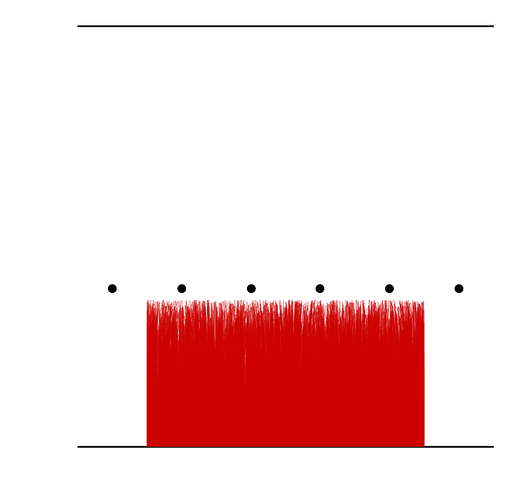hello This is my code
int main(int argc, char * argv[]) {
TApplication app("app", &argc, argv);
// Periodicity (wire spacing) [cm].
constexpr double period = 0.1;
// Wire diameters [cm]直径
// Gate wires.
constexpr double dg = 0.01;
// Voltage settings [V].
// Gate wires.
constexpr double vg = -460.;
// HV plane (drift field).
constexpr double yHV = 0.2;
constexpr double vHV = -5;
// Setup the gas.
MediumMagboltz gas;
// Set the temperature [K] and pressure [Torr].
gas.SetComposition("xe", 100.); //100%Xe
gas.SetTemperature(293.15);
gas.SetPressure(15*760.);
gas.Initialise(true);
// Load the ion mobilities.
const std::string path = std::getenv("GARFIELD_HOME");
gas.LoadIonMobility(path + "/Data/IonMobility_Xe+_P12_Xe.txt");
// Setup the electric field.
ComponentAnalyticField cmp;
cmp.SetMedium(&gas);
cmp.SetPeriodicityX(period);
// Add the gate wires.
constexpr double xg1 = 0.5 * period;
constexpr double xg2 = 0.75 * period;
constexpr double yg = 0.075;
cmp.AddWire(xg1, yg, dg, vg , "g+", 100., 50., 19.3, 1);
//cmp.AddWire(xg2, yg, dg, vg , "g-", 100., 50., 19.3, 1);
// Add the planes.
cmp.AddPlaneY(0., -1000., "pad_plane");
cmp.AddPlaneY(yHV, vHV, "HV");
// Request weighting-field calculation for the pad plane.
cmp.AddReadout("pad_plane");
// Make a sensor.
Sensor sensor;
sensor.AddComponent(&cmp);
sensor.AddElectrode(&cmp, "pad_plane");
// Change the time window for less/better resolution in time
// (effect on convolution can be important).
const double tstep = 1000; //信号采样步长,0.1微秒 (ns,s=1e9ns)
const double tmin = 0; //信号采样时间下限
const double tmax=3000000; //上限,根据结果调整 暂定1ms
const unsigned int nbins = (tmax-tmin)/tstep; //信号采样时间间隔数 ,随机取样
sensor.SetTimeWindow(tmin, tstep, nbins);
constexpr double xmin = -3 * period;
constexpr double xmax = 3 * period;
sensor.SetArea(xmin, 0., -1., xmax, yHV, 1.);
// Plot isopotential contours.
ViewField fieldView;
fieldView.SetSensor(&sensor);
fieldView.SetArea(xmin, 0., xmax, 0.2);
fieldView.SetVoltageRange(0., 1000.);
fieldView.PlotContour();
// Calculate ion drift lines using the RKF method.
DriftLineRKF driftline;
driftline.SetSensor(&sensor);
// Plot the drift line.
ViewDrift driftView;
// Comment this out when calculating many drift lines.
driftline.EnablePlotting(&driftView);
// const int nIons = 10000;
const int nIons = 10000;
// Count the number of ions that drift to
// plane, cathode, gate or drift volume, respectively.
for (int i = 0; i < nIons; i++) {
// Sample the starting point of the ion around the sense wire.
const double x0 = 0.4* RndmUniformPos()-0.2;//25mm
const double y0 = 0.07* RndmUniformPos();
driftline.DriftIon(x0, y0, 0, 0);
}
// Plot the drift lines on top of the cell layout.
ViewCell cellView;
cellView.SetComponent(&cmp);
cellView.SetArea(xmin, 0., xmax, 0.2);
cellView.Plot2d();
driftView.SetArea(xmin, 0., xmax, 0.2);
driftView.SetCanvas(cellView.GetCanvas());
driftView.Plot(true, false);
// Plot the induced current.
ViewSignal signalView;
signalView.SetSensor(&sensor);
TCanvas c1("c1", "", 800, 600);
signalView.SetCanvas(&c1);
signalView.PlotSignal("pad_plane");
// Convolute with the transfer function and plot again.
sensor.SetTransferFunction(transfer);
constexpr bool fft = true;
sensor.ConvoluteSignals(fft);
TCanvas c2("c2", "", 800, 600);
signalView.SetCanvas(&c2);
signalView.SetLabelY("signal [mV]");
signalView.PlotSignal("pad_plane");
app.Run(true);
}
